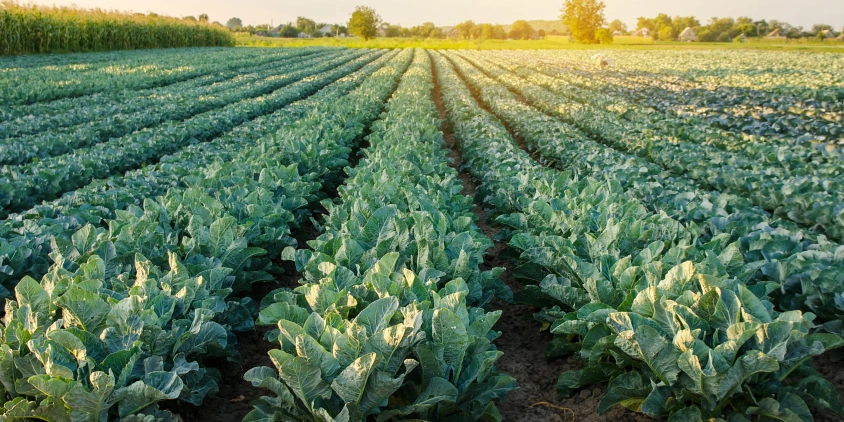
Growing Broccoli: Type Selection, Planting, And Harvest
Growing broccoli, while not the most challenging, demands a nuanced approach on a commercial scale. The crop’s preference for cool temperatures and consistent moisture makes it somewhat picky about growing conditions. Sensitivity to heat can lead to premature flowering or “bolting,” potentially reducing yields if not managed properly. However, the plant’s relatively quick growth cycle and ability to produce secondary shoots after the main head harvest balance these challenges of broccoli farming. With proper care, including precise irrigation, targeted fertilization, and effective pest management, growers can achieve high yields. As consumer demand for this nutritious vegetable continues to rise, mastering broccoli cultivation can open lucrative market opportunities for savvy farmers.
Types Of Broccoli
Broccoli’s versatility shines through its diverse varieties, allowing farmers to grow this nutritious vegetable from early spring through late fall. Its varieties fall into two categories, depending on when they mature:
- Early varieties, such as Green Magic, Imperial, and Tendergreen, typically mature less than 65 days after transplanting. These fast-growing broccoli varieties are ideal for spring planting, as they can grow and produce harvests before the summer heat sets in. Early varieties often have smaller heads, but quick production and the potential for multiple harvests through prolific side-shoot development make up for this.
- Mid- to late-season varieties, such as Premium Crop, Emerald Crown, and Winter Green, typically reach maturity in over 65 days. This type of broccoli is great for growing and harvesting in the fall since it can withstand lower temperatures. They generally produce larger, denser heads than early varieties and are known for their consistent yields.
Choosing between types depends on your climate, growing season length, and specific agricultural and commercial needs.
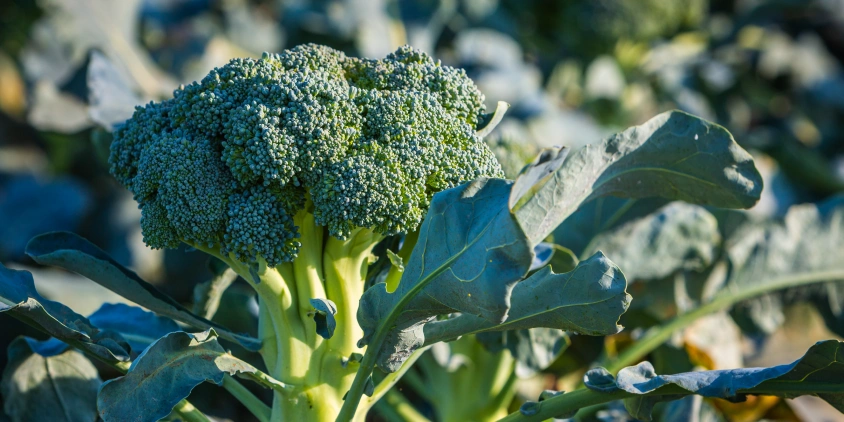
Best Growing Conditions For Broccoli
The environment surrounding the crop greatly influences its growth and yield. Climate, water, and soil are essential growing conditions to consider.
Temperature And Sun Requirements
Mastering the crop’s cultivation requires knowing its climate requirements. While seeds germinate at 75°F (24°C), established broccoli plants prefer cooler growing temperatures, between 60 and 70°F (15 and 21°C). Timing is key: if you can’t plant early in the spring to avoid the peak summer heat in your growing region, grow the crop from July through fall colds and harvest before a killing frost. Broccoli requirements include full sun exposure (at least six hours), though some afternoon shade may be necessary to prevent the crop from heat stress and bolting in scorching regions.
Typical for the Mediterranean region, it grows well in areas with cold and moist winters.
Knowing the hyperlocal peak temperatures during the summer and their timing will assist you in scheduling the broccoli growing season. Thanks to EOSDA Crop Monitoring, you have access to temperature insights specific to your field. With historical records and up to 14-day forecasts at your fingertips, you can make informed decisions on planting times and field operations, ensuring optimal growing conditions for your crop.
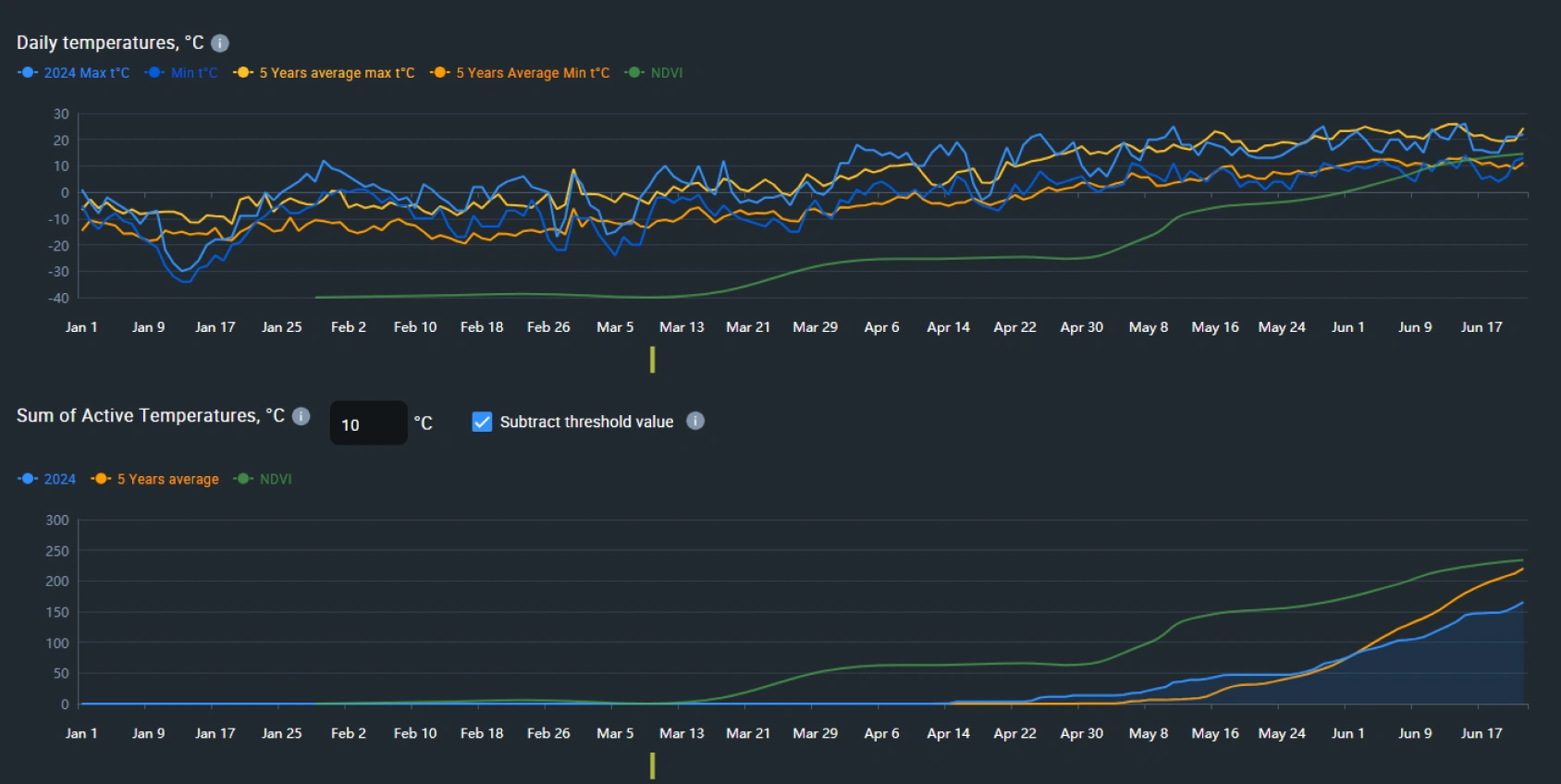
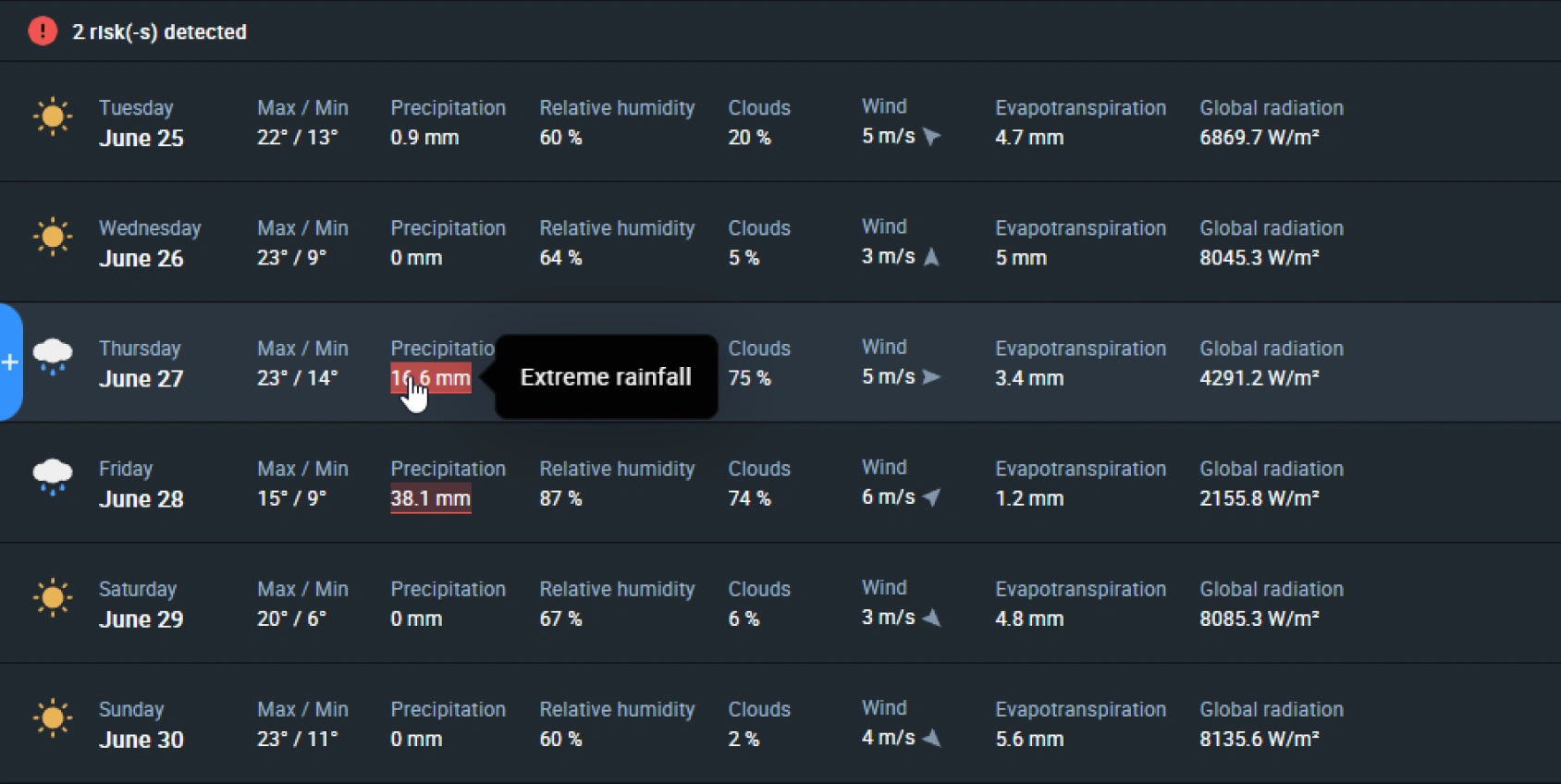
Soil Requirements
This Brassica vegetable grows and performs well in rich, slightly acidic soil (6.0 to 7.0pH) . Before planting, conduct a soil test, and add lime if the soil pH is unsuitable for broccoli. To boost soil fertility and improve soil structure, incorporate compost or aged manure.
Either sandy or clay soil is fine for growing broccoli plants, as long as it drains well. Raised beds watered through drip irrigation systems can ensure such conditions.
Water Requirements
Sufficient moisture levels support healthy growth and proper head formation. When natural rainfall falls short, growers must step in with supplemental watering to meet moisture requirements.
A consistent water supply, ideally between 1 and 1.5 inches (250 and 380 mm), is optimal for growing broccoli.
By maintaining optimal water conditions, either through natural precipitation or irrigation, farmers can ensure their crops develop to their full potential.
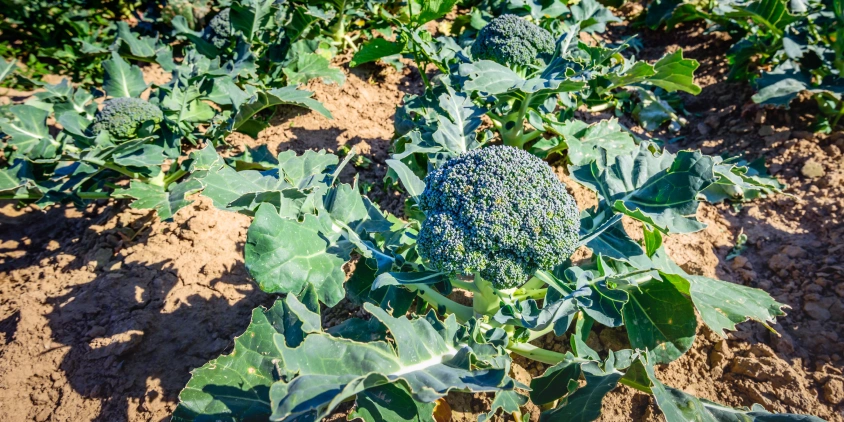
Methods And Timing Of Planting Broccoli
The planting phase is critical for establishing a healthy crop. In this section, we’ll go over the ins and outs of different planting methods, such as indoor seed starting and direct field sowing, and cover timing considerations for both spring and fall crops.
How And When To Plant Broccoli
Thriving crops begin with the proper planting timing and technique. Growers can choose between two planting methods, each with its own advantages depending on the specific broccoli growing conditions and agricultural objectives:
- Transplanting pre-started seedlings. This method starts indoors, with seeds planted in a high-quality mix 6–8 weeks before the last projected frost. Pre-starting is beneficial for spring crops and can be optimized in commercial settings through the use of controlled greenhouse environments. Once seedlings develop two true leaf sets, usually at 4–6 weeks old, they’re ready for transplanting. Move them outdoors 2–4 weeks before the last projected frost, giving them time to establish and acclimate before the frost hits.
- Direct sowing. It offers a simpler alternative, suitable for both spring and fall crops. For spring crops, plant seeds 2–4 weeks before the last expected frost, and for fall crops, plant midway through summer. After emergence, thin seedlings to prevent overcrowding and ensure optimal nutrient access throughout the growing season. Direct broccoli sowing can be particularly effective for commercial operations when combined with precision seeding equipment, which ensures uniform seed distribution and depth.
Regardless of the chosen planting method, prioritize proper soil preparation and use certified, high-quality seeds.
How Deep And Far Apart To Plant Broccoli
To ensure robust and even growth, sow seeds 0.5 inches (1.3 cm) below the soil surface or, when transplanting seedlings, match their container depth to avoid stress. Aim for broccoli plant spacing of 18–24 inches (46–61 cm) and row spacing of 24-36 inches (61–91 cm) . This spacing strategy enhances airflow, minimizes disease risk, and fosters healthy plant development. Commercial growers should pay particular attention to proper spacing, as it’s key to achieving uniform growth and facilitating crop management and harvesting processes.
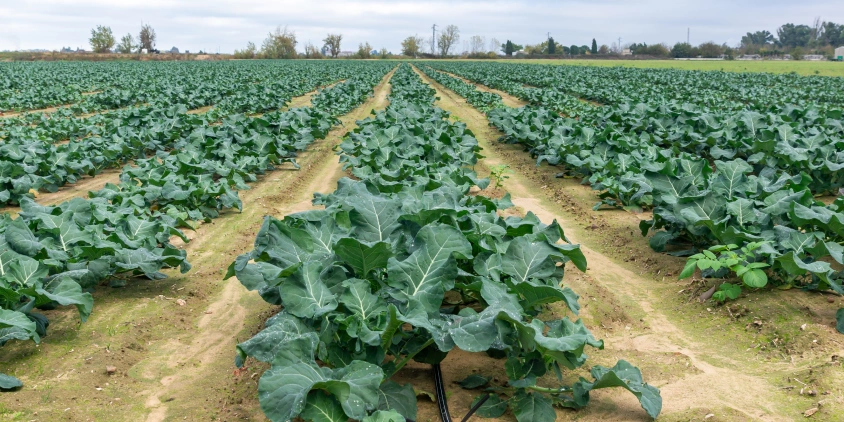
How To Care For Broccoli Plants
Successful cultivation requires adjusting soil moisture, nutritional levels, and pest management, among other things. Let’s look at the critical care practices for growing a bumper crop.
EOSDA Crop Monitoring
Fields monitoring platform, leveraging high-resolution satellite images to identify and react to any changes remotely!
Precise Fertilizing
This Brassica vegetable thrives when provided with ample nutrients, making regular fertilization highly beneficial. Kickstart its growth with a balanced pre-planting NPK fertilizer. Then, provide your plants with nitrogen-rich fertilizer applications around the 3-to-4-week mark and at the beginning of the head formation stage.
Ideally, determine your application rates based on recent soil test reports. If soil testing isn’t possible, apply 120-100-100 pounds per acre (134-112-112 kg/ha) of NPK fertilizer for broadcasting on broccoli fields, or 35-50-50 pounds per acre (39-56-56 kg/ha) for bandedplanting . Be cautious not to overfertilize, as this can cause leaf overgrowth at the expense of heads.
Tap into EOSDA Crop Monitoring’s VRA (variable rate application) maps to supercharge your fertilization strategy. With these satellite-based maps uploaded to agricultural machinery, you can optimize fertilizer allocation by focusing your efforts on medium- and high-vegetation areas, which promise to reward you with higher yields.
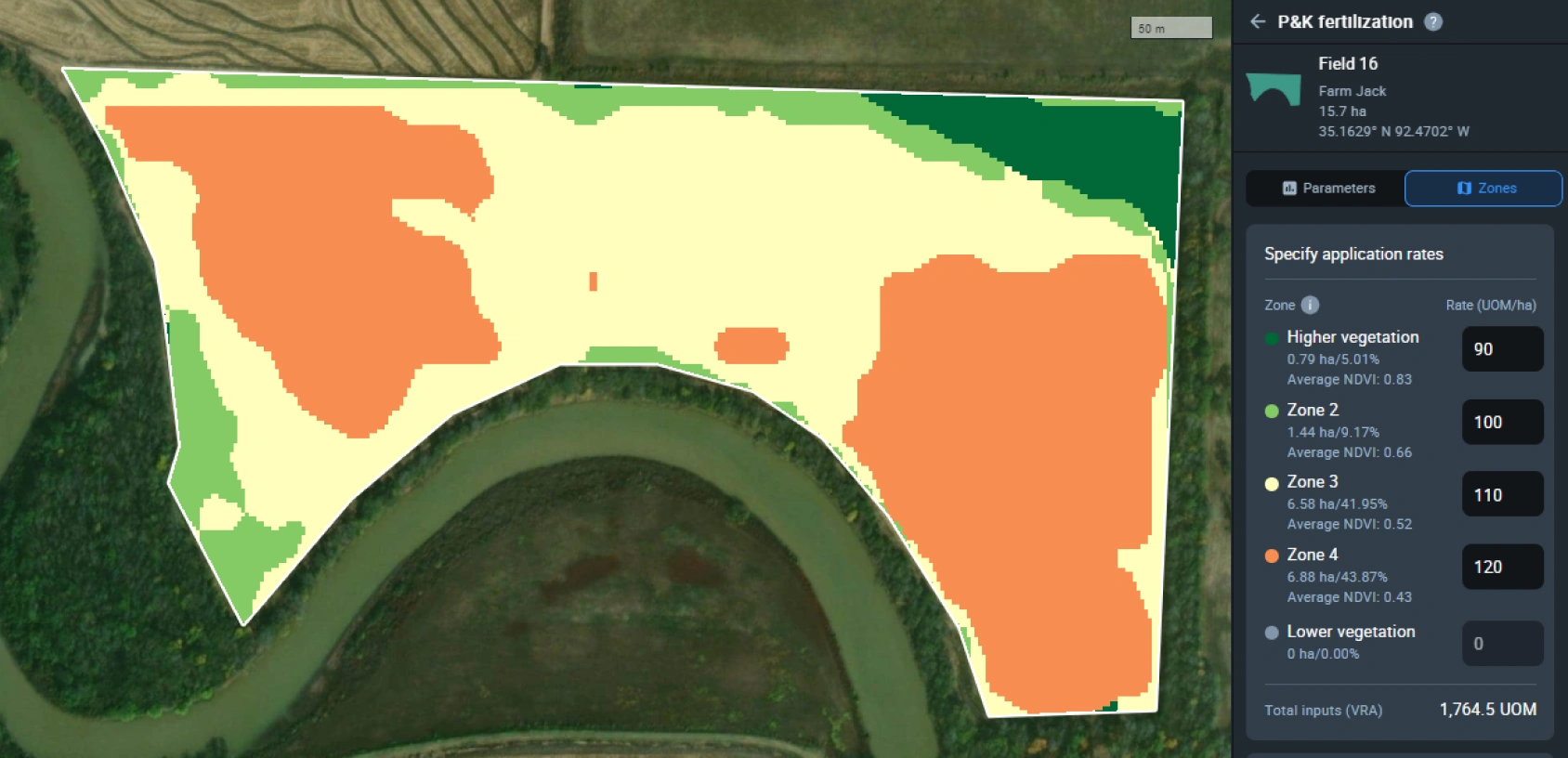
Managing Pests And Diseases
Broccoli, like many other Brassica crops, faces threats from both insect pests, such as flea beetles and cabbage worms, and various fungal and bacterial pathogens, such as black rot and downy mildew. The cool, humid growing conditions that the plant prefers can create an ideal environment for fungi to thrive.
Successful management of these issues requires a multifaceted approach, combining preventive measures, regular scouting throughout the growing season, and targeted treatments when necessary. To aid in quick risk identification and response, here’s a breakdown of the most significant pests and diseases, along with their symptoms and recommended control measures.
| Pest/Disease | Symptoms | Control |
|---|---|---|
| Aphids |
|
|
| Cabbage worms |
|
|
| Flea beetles |
|
|
| Downy mildew |
|
|
| Black rot |
|
|
| Clubroot |
|
|
Implementing a robust crop rotation strategy is crucial for mitigating pest and disease risks in broccoli cultivation. Crop monitoring systems offer powerful tools to support this approach. Our platform’s Crop rotation feature allows farmers to track planting and harvesting histories across multiple fields, providing insights that can inform sustainable agriculture practices and help break pest and disease cycles.

Consistent Watering
Broccoli grows well when consistently moistened, which makes proper irrigation a cornerstone of successful cultivation. Be sure to water your growing plants well, paying extra attention during heat waves or dry spells. Opt for drip irrigation or soaker hose systems to target the root zone and conserve water while reducing fungal disease risks.
To ensure that your plants receive timely and adequate watering, upgrade your irrigation strategy using digital tools such as the Field activity log in our platform, which allows large-scale crop producers to:
- plan watering schedules;
- specify application rates;
- designate responsible workers.
This feature not only streamlines your watering routine but also helps you get valuable insights into water utilization and expenses to optimize your input allocation.
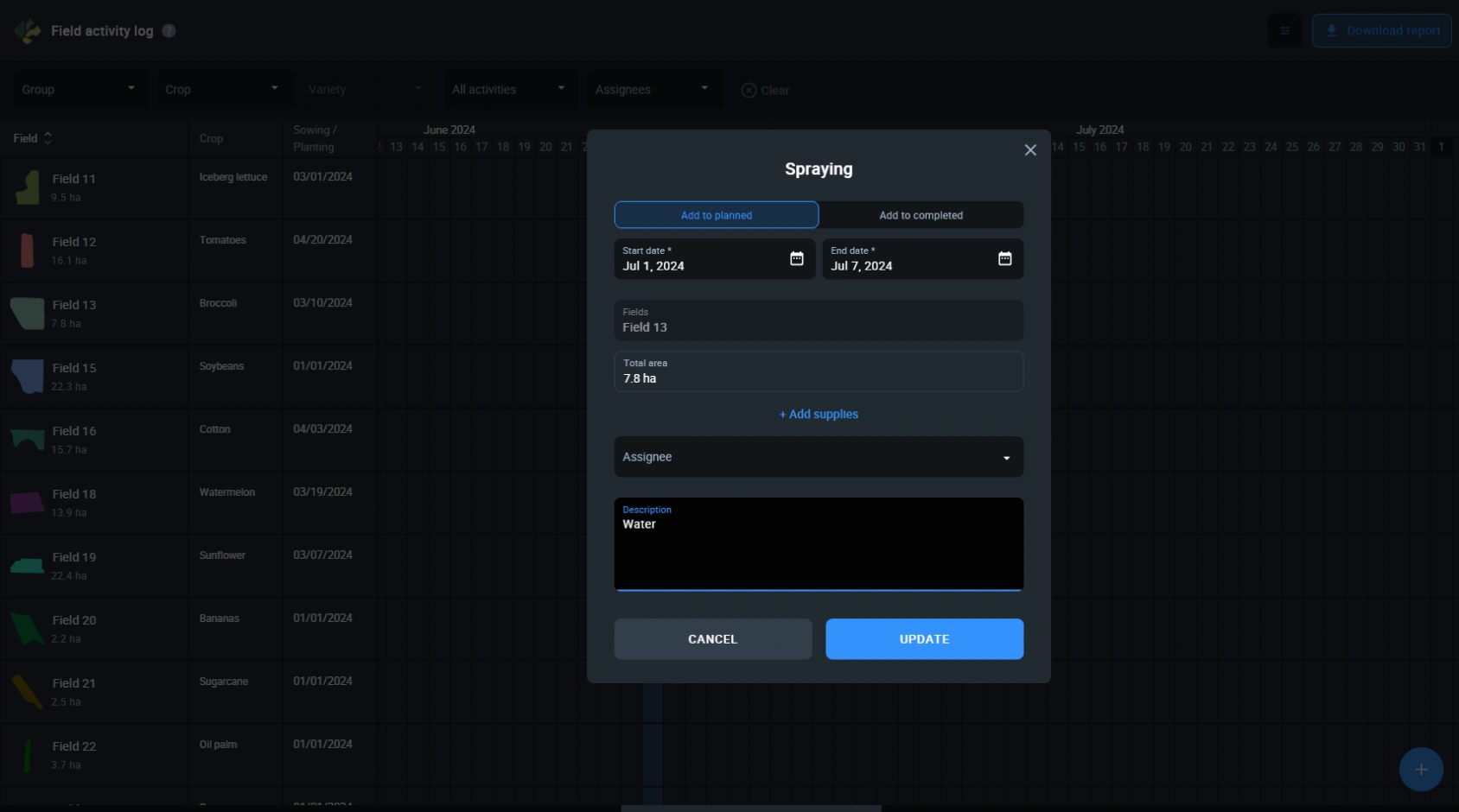
How Long Does Broccoli Take To Grow?
The time required for broccoli to grow from seed to harvest typically ranges from 50 to 100 days, influenced by variety selection and growing conditions. Early varieties are the quickest, maturing in 50–65 days, while mid- and late-season varieties need 65–100 days. This range of growth periods gives farmers flexibility to adapt their crop production to various growing conditions and seasonal constraints.
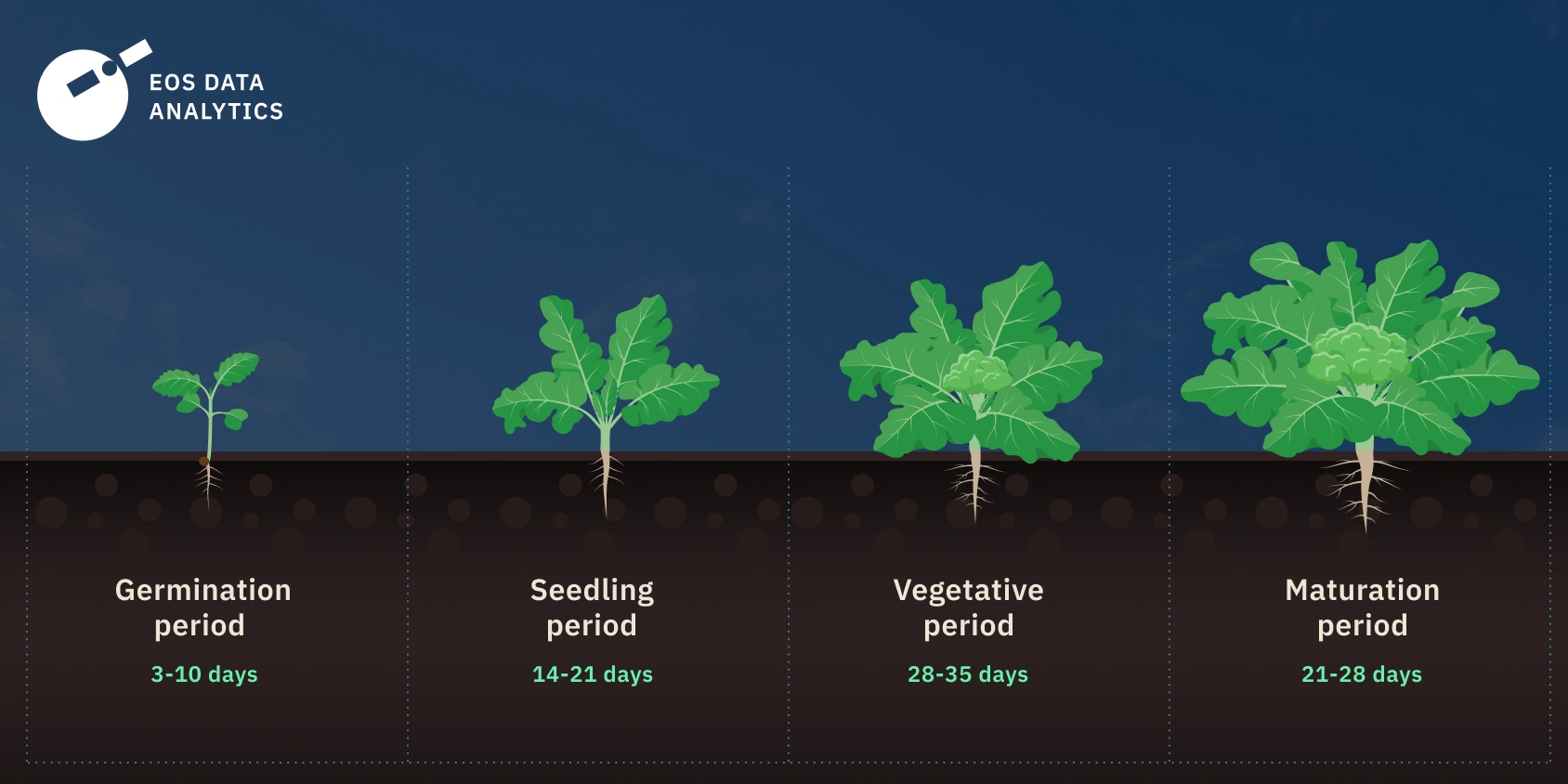
How To Harvest Broccoli
Successful broccoli harvesting begins with proper planning. Utilize EOSDA’s custom yield estimation technologies to inform your harvesting decisions for each field. Harvest when plant heads feel firm and tight, before any buds start to bloom. Use a sharp knife to cut the main head, retaining a portion of the stem, and expect smaller side shoots for later harvests from many varieties.
Check for hidden worms and select properly sized heads, typically 6 inches (15 cm) in diameter, to ensure marketable vegetables. Post-harvest, maintain peak freshness by storing your vegetables in a humid and cool 32–36°F (0–2°C) environment. By following these steps, crop producers will help their broccoli grow abundantly and stand out in the marketplace.
About the author:
Vasyl Cherlinka is a Doctor of Biosciences specializing in pedology (soil science), with 30 years of experience in the field. He attended the engineering college in Ukraine and received his degree in agrochemistry, agronomy and soil science in the Chernivtsi National University. Since 2018, Dr. Cherlinka has been advising EOSDA on problems in soil science, agronomy, and agrochemistry.
Recent articles
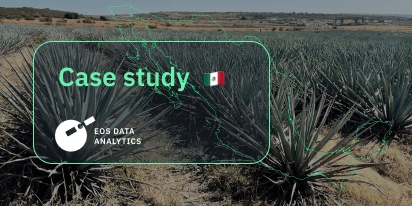
Digital Tools Improve Soil Health And Yields In Mexico
EOSDA and ITTA supported a Guanajuato farm with contour-line planning, monitoring tools, and practical guidance to reduce soil erosion and improve yields in the long run.

Analyze 2025 & Plan Your Best Year Yet: LandViewer Christmas Offer
It’s the most wonderful time of the year! The Christmas holidays are here, and so is your chance to analyze 2025 and plan a prosperous 2026 with more affordable Pro plans in LandViewer.

EOSDA Models Climate Change Impact On Sugarcane Yields
EOSDA modeled future temperature, rainfall, and other climate impacts on Veracruz sugarcane. The results help growers plan long-term adaptation strategies, including timing, varieties, and irrigation.